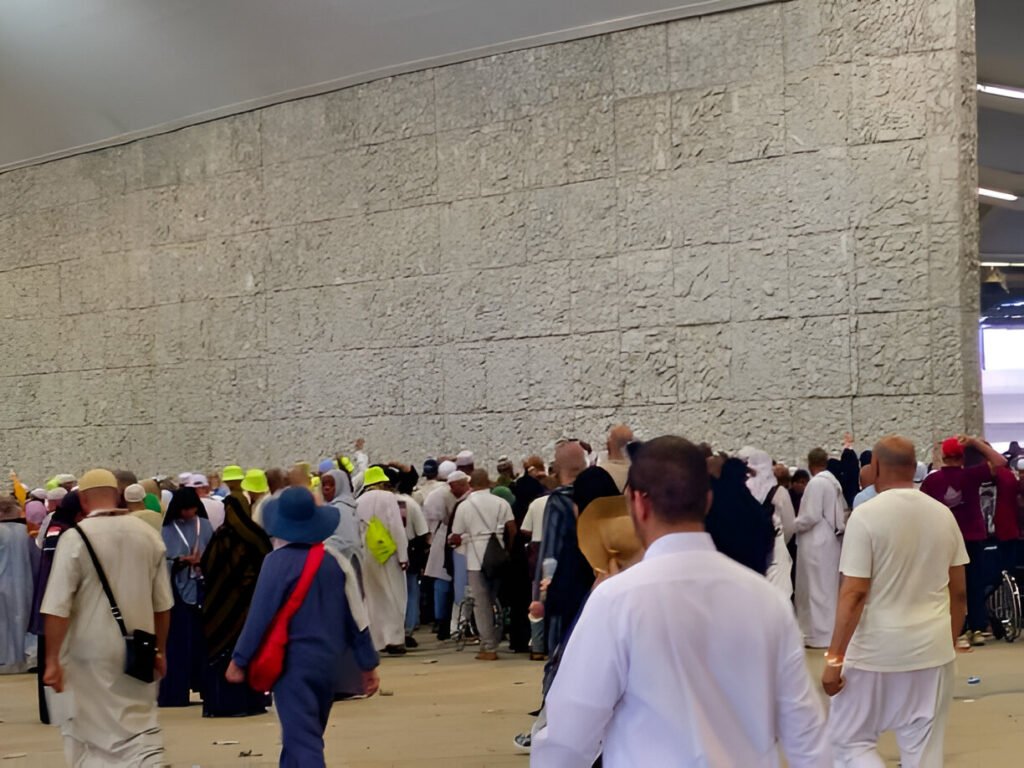- Leaving Muzdalifah
- The Boundaries of Jamaraat
- The History of Throwing Pebbles or Its Reason
- The Timing for Throwing Pebbles
- How to Throw Pebbles
- Important Notes
- Performing Rami on Behalf of Others
- The Last Moment for Reciting Talbiyah
- After Rami
- Some Information About Jamaraat
- Common Mistakes and Innovations in Pebble-Throwing
On the 10th of Dhul-Hijjah, the following actions should be performed: This day is one of the most significant days of Hajj. The Messenger (peace be upon him) referred to it as the greatest day of Hajj. On this day, five acts need to be completed: First: throwing pebbles at the larger Jamrah, Second: sacrificing an animal, Third: shaving or trimming the hair, Fourth: performing Tawaf al-Ifadah, and Fifth: performing Sa’i. (References: Abu Dawood-1945, Tirmidhi-958)
Leaving Muzdalifah
Before sunrise, leave Muzdalifah heading toward Mina while reciting Talbiyah. At this time, there will be large crowds of people, and no buses will be available on the roads, so everyone will need to walk to Jamaraat. Be mentally prepared to walk 10-15 kilometers, as this is one of the most challenging aspects of Hajj. Always stay in a group, as many people get separated and lost here. When passing through the Valley of Muhassir, try to walk quickly because the Messenger (peace be upon him) did so, as Allah’s punishment once descended here. On the way to Jamaraat, if you pass your tent in Mina, take some rest and eat before heading toward Jamarat. Continue reciting Talbiyah as much as possible, as its time is nearing an end. Also, recite Takbeer al-Tashreeq frequently. It is better if the group leader carries a flag to guide everyone.
The Boundaries of Jamaraat
The Jamaraat area is located within the boundaries of Mina. Throwing pebbles at Rami is one of the commands of Allah. The Messenger (peace be upon him) said, “The Tawaf of the House (Kaaba), Sa’i between Safa and Marwa, and the throwing of pebbles at Jamaraat are all meant to establish the remembrance of Allah.” It is mentioned in a Hadith, “Your pebble throwing is stored for you (as rewards).” (Tirmidhi-902)
The History of Throwing Pebbles or Its Reason
While Prophet Ibrahim (peace be upon him) was taking Ismail to sacrifice him, Satan attempted to mislead them, and Ibrahim (peace be upon him) threw pebbles at Satan. Some people mistakenly believe that Satan is tied up at Jamaraat, but this is incorrect. Throwing pebbles is an act of worship and obedience to Allah, symbolizing the renouncement of following Satan. Referring to the Jamaraat as “big Satan” or “small Satan” is also incorrect.
The Timing for Throwing Pebbles
The Messenger (peace be upon him) threw pebbles 1-2 hours after sunrise. Accordingly, it is Sunnah and preferable to throw pebbles before the sun reaches its zenith. However, throwing pebbles is permissible from sunrise until Fajr of the 11th of Dhul-Hijjah. Since it is challenging for the 30 million pilgrims to throw pebbles during the Sunnah time, there is no issue with doing so later. (References: Bukhari-1705, Nasai-3063) Women, children, the sick, and the elderly who leave Muzdalifah for Mina at midnight should not throw pebbles before sunrise. They may do so after sunrise, in the afternoon, or at night when the Jamaraat area is less crowded. (References: Nasai-3065, Tirmidhi-893)
How to Throw Pebbles
If possible, face the Jamaraat, keeping the Kaaba to your left and Mina to your right, or stand in any convenient position. Raise your right hand and throw seven pebbles one by one, saying at the start of each throw: (References: Bukhari-1750, Muslim-3022, Nasai-3054)
اللهُ أَكْبَرُ
“Allahu Akbar” (Allah is the Greatest).
Stand 1-2 meters away or at a comfortable distance from the Jamaraat, ensuring the pebbles hit the pillar or fall into the Jamaraat basin. If a pebble does not land in the basin, throw another pebble in its place. For this reason, it is advisable to carry extra pebbles. Pebbles can be held and thrown using any fingers without a specific method. After completing your own pebble throwing, you may perform Rami on behalf of someone else in the same manner.
Important Notes
Pebbles cannot be thrown at the larger Jamrah before sunrise on the 10th of Dhul-Hijjah. Throwing pebbles at the larger Jamrah is obligatory. Failure to perform Rami within the specified time requires a sacrificial offering (damm). (Reference: Nasai-30005)
Performing Rami on Behalf of Others
For the sick and elderly men and women, or for children, anyone can perform Rami as their representative. In this case, the representative must be a pilgrim performing Hajj that year. They should first throw pebbles for themselves and then throw for others. Nowadays, many people, especially women, appoint someone else to perform Rami for them, citing minor physical weakness or illness, and they stay sleeping in the Mina tents. This is inappropriate. It is preferable to throw pebbles at oneself. Unless someone is very ill, unable to move, or risks worsening their condition by going to Jamaraat, or if there is an extreme crowd, everyone should go to Jamaraat to perform their own Rami.
The Last Moment for Reciting Talbiyah
Using the one-way walkway, climb to any floor of the Jamaraat complex via a bridge, elevator, or escalator. Since you are entering Jamaraat through Mina, passing near Masjid Khaif, you will first pass the small Jamrah (Jamrat al-Sughra), then the middle Jamrah (Jamrat al-Wusta), and finally reach the larger Jamrah (Jamrat al-Aqabah). Today, there is no pebble-throwing at the small or middle Jamrah. Instead of heading directly toward the larger Jamrah for throwing, walk around the Jamaraat to find a less crowded spot. Approach as close to the Jamrah as possible and throw the pebbles. Upon reaching the larger Jamrah, stop reciting Talbiyah. The recitation of Talbiyah ends here. (References: Bukhari-1685, Muslim-2978)
After Rami
After completing Rami, there is no prescribed du’a at this spot mentioned in any Hadith. Leave Jamaraat using the bridge toward Makkah. The next task is sacrificing the animal (Hadi). If you have already paid for the sacrifice through a bank, there is nothing further to do. Once the sacrifice is completed, you can shave or trim your hair and exit the state of Ihram. If you intend to personally perform the sacrifice, go to Mu’aisim to do so. Today is Eid day in Saudi Arabia; however, pilgrims do not need to offer the Eid prayer. Perform all the obligatory prayers on this day at their earliest times, shortening them. (Reference: Ibn Majah-3032)
Some Information About Jamaraat
The Jamaraat is a five-story building complex. It is opened for use from the 10th to the 13th of Dhul-Hijjah during Hajj and remains closed the rest of the year. Various connecting roads lead to Jamaraat from Mina, Aziziyah, and Shisha. Some Hajj agencies offering Fitrah (shifting accommodations) packages stay in Aziziyah and Shisha near Jamaraat. On one side of Jamaraat, there is a train station. Trains run from Jamaraat to the Mina-Muzdalifah border.
In the past, many people were trampled to death while performing Rami at Jamaraat, causing fear among pilgrims. However, safe and easy arrangements have now been made for pebble-throwing.
All roads to Jamaraat are one-way. If traveling from Mina to Jamaraat, you will ascend via bridges or escalators. After throwing the pebbles, you will exit on the other side of Jamaraat, heading toward Makkah.
You will see many security personnel and Hajj management staff at Jamaraat.
Do not carry large bags on your head or shoulders while going to Jamaraat. Security personnel may stop you and deny entry. However, small handbags or shoulder bags are allowed.
Inside the Jamaraat building, you will see large air-cooling fans installed to provide cool air to pilgrims. Around Jamaraat, you will find many pebbles and plastic bottles on the ground. Many people get lost here, so always stay with your group. It is helpful if the group leader carries a small flag.
Keep in mind that for the next three days, you will have to walk from Mina to Jamaraat for pebble-throwing and return to your tents in Mina on foot. Prepare for this walk. No vehicles are allowed in the Jamaraat area. Pilgrims with shuttle train tickets can easily travel from Mina to Jamaraat and perform Rami. Some VIP pilgrims are flown by helicopter to the rooftop of the Jamaraat building to perform Rami.
Common Mistakes and Innovations in Pebble-Throwing
Performing ghusl or ablution before pebble-throwing.
Washing the pebbles before throwing them.
Throwing 2-3 or all 7 pebbles at once.
Saying Subhanallah or other dhikr instead of Takbir. Adding anything to the Takbir.
Believing they are throwing pebbles at Satan and becoming angry, cursing the Jamaraat.
Throwing large stones, sandals, or pieces of wood at the Jamaraat, which is an act of excessiveness prohibited by the Messenger (peace be upon him).
Pushing and shoving to get closer for pebble-throwing.
Believing there is a specific way to hold the pebble, such as pinching it between the thumb and index finger or placing it on the back of the thumb before throwing.
Believing there is a specific spot to stand for throwing pebbles or that there must be at least a five-hand distance between the person and the Jamrah.



